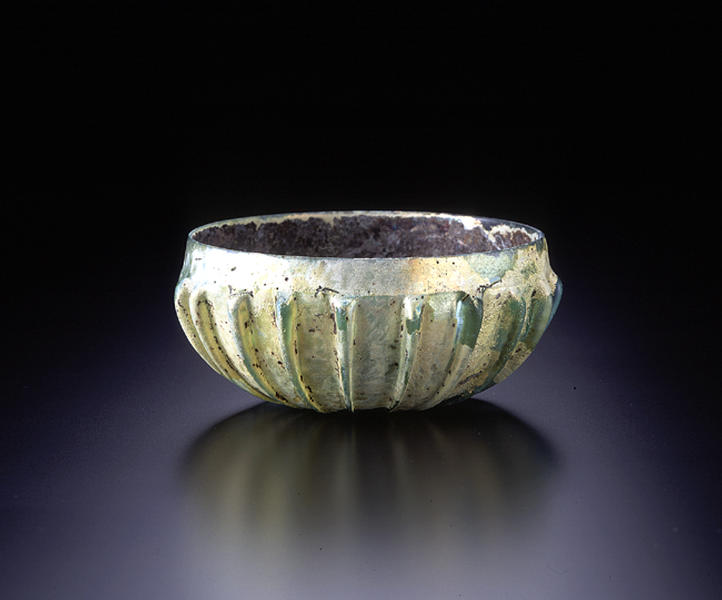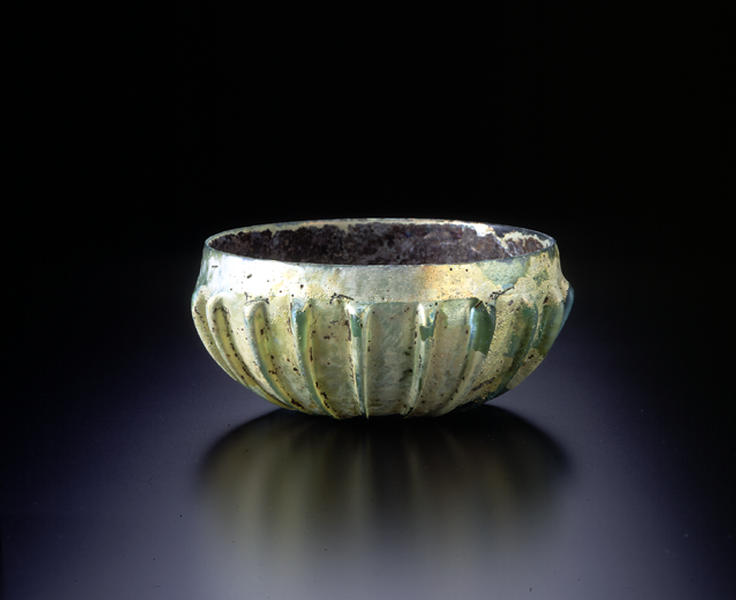Ribbed Bowl
- Eastern Mediterranean or Italy
- 1st century B.C. - 1st century A.D.
- Glass
- H-5.5 D-12
Catalogue Entry
Turquoise translucent glass. The mouth turns slightly in while the side walls are slightly swelling. The base has a minor hollow in its center. Two thin horizontal grooves are carved into the lower section of the inner body. The outer surface has 19 protruding ribs. These ribs are of identical size and evenly spaced, rising almost vertically from the vessel walls. A gold colored iridescence covers a majority of the surface.
Bowls with ribbed decoration were made in the Palestrina coastal area of Sicily and the main Italian peninsula from the first century BC through the first century AD. This is one of the representative glass vessel shapes for this period. These vessels resemble the cast glass vessels with horizontal groove decoration in terms of quality and color of glass, vessel shape and production methods, and it is thought that both types were created in the same workshops. There are many theories regarding the formation methods used for these ribbed bowls, and the following method can also be suggested. A round tray shape was made from fired glass and then a mold with raised radiating ribs would be pressed into the surface of the hot glass to create ribs on the outer surface of the round disk. This round disk would then be placed on an upside down bowl shaped mold, and then reheated in the kiln until the disk melts down to follow the bowl shape. After the bowl shape was created, the mouth rim was carved flat and the overall form polished.
Catalogue Entry(Bac#042)
1st century B.C.‐1st century A.D.
Glass
(a)H. 5.5 cm, Mouth dia. 12.0 cm
(b)H. 4.8 cm, Mouth dia. 14.8 cm
cH. 4.2 cm, Mouth dia. 15.0 cm
Augustan Rome subjugated the Ptolemaic dynasty of Egypt and this brought free trade and commerce to the eastern Mediterranean region. Superb glass vessels spread throughout the Roman world, and this trade enlivened the Roman glass workshops and led to distinctive developments. This type of ribbed pattern glass bowl was made in great numbers in the early Imperial Roman Italian peninsula or in the Syrian/Palestine region. These bowls were made of single color, translucent glass.
There are various explanations of how these ribs were produced, with one explanation stating that a round mold with radiating ribs was heated and pressed into a soft lump of glass. Then this mold and pressed glass lump would be placed on top of a semi-spherical mold, heated again and allowed to drape over it, the rim is finished and the bowl is complete. Another idea is that a bowl-shaped mold with ribs was formed, then glass material was put into the mold, and then an inner mold was placed on top like a lid with a heavy rock. The whole configuration was the heated and formed, the rim and other details were carved and finished to complete the bowl. Before working with blown glass, the Roman glass workshops created superb works through these casting and "sagging" techniques.
Ribbed Bowl
Ribbed Bowl

